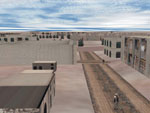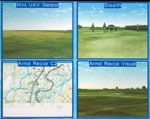Virtual Theater Prepares Warfighters
 |
| Thales U.K.’s Battlespace Transformation Center in Crawley, England, is training British forces’ headquarters personnel before they deploy to Afghanistan. Specifically tuned to training intelligence, surveillance, target acquisition and reconnaissance (ISTAR) specialists, the simulation provides sensor feeds from a variety of ground and aerial platforms. The virtual world accurately replicates towns in Afghanistan’s Helmand Province to familiarize personnel with their operational area. |
A new virtual training facility is helping British troops hone their command and control skills before they deploy to
This pre-deployment training takes place at Thales United Kingdom’s
The
The ISTAR Theater is a major part of the new facility. One wall of the theater features a multidisplay media wall representing a joint operations center. The displays can present data from a variety of ISTAR sources such as Reaper or Watchkeeper UAVs. Wright explains that his company initially assumed that the media wall would be used to study how a command center ingests information. However, personnel at the brigade and battle group level were more interested in understanding how to operate their equipment more efficiently.
A typical brigade or tactical headquarters features a central table with an operational map on it. Plastic overlays and grease pencils provide situational awareness. The ISTAR liaison officers operate terminals around the map table and relay information from simulated ground and airborne sensors to the commanders at the map table. Wright notes that the
The current ISTAR simulation and training program began in late 2005 and early 2006. Wright notes that it grew out of discussions with members of the Royal Marines who were being reassigned to
Another part of the
A typical operational scenario displays simulated ISTAR imagery from a town in
Headquarters teams receive four days of training. One day is used as a debriefing or preparation day with three core days focusing on specific scenarios. Wright notes that the U.K. Ministry of Defence (MOD) and Thales are discussing methods to provide specialized “niche” training to units during the late stages of operational buildup. Once teams have conducted comprehensive training or a full mission exercise in a live environment, they work through specific scenarios. He admits that some uncertainly remains whether synthetic training is best immediately before or after a major exercise.
 |
| An image of the screen is shown in the ISTAR Theater. A key part of the Thales Battlespace Transformation Center, the ISTAR Theater replicates the data and tactical information being fed into a battalion or battle group headquarters. |
“We were specifically interested in bringing to life the operational and procedural training that personnel find very hard to get within normal live exercises. Data is typically used as the tap to control the pace of exercises. If an exercise is going well, commanders will receive less intelligence feed. If it’s going badly, they will receive more. But it [the exercise] doesn’t adequately practice the ISTAR team itself,” Wright says. He adds that through the battle lab, his company seeks to provide a detailed virtual reality environment where ISTAR collection assets can provide high-fidelity information within a counterinsurgency operation.
Participants can share live operational information during the simulation. For example, UAV operators can describe what they see on their display over a voice or chat network and relay this information to the operator of another tactical UAV in the same area. Wright says that this function allows headquarters and operational personnel to collaborate by visually identifying the same targets.
Wright contends that a key feature of the center’s training is its accurate representation of the Afghan terrain in which British forces operate. He contrasts this with the MOD’s current standard training simulation that uses a generic environment based on geographical representations of regions in
Based on feedback from several years of simulation training, Wright says that his company is making its new facilities more agile and adaptable so that they can be quickly reconfigured. He notes that historically, simulation facilities required substantial modifications to implement changes. The goal is to reduce the turnaround time to a few weeks for major changes or days or hours for minor modifications.
This adaptability is partially an effort to keep up with ISTAR personnel who learn a range of new lessons about enemy behavior while in the field. Training centers must then modify their simulations and equipment to reflect this new military knowledge. One example of these changes is the ability to section off parts of the facility quickly to provide remote cells to operate ISTAR assets and collaboration with a range of new coalition partners.
To maintain flexibility, the company is increasingly looking at interoperable and adaptable commercial technologies. Wright notes that this is a shift from the bespoke training systems that had been procured and developed in the past.
Thales also is considering a virtual forward air controller system, simulating a ground-based observer designating targets for air assets. The simulator would allow a soldier to interact with virtual
The company also has examined the use of modeling and simulation systems for use by deployed forces. Wright says that Thales considered developing mobile trailers to allow personnel to train on new equipment rushed into an operational theater. But he notes that one of the challenges for such a system is the limited time deployed troops have for simulator training. Although it would be appreciated, Wright says that commanders do not know if troops in the field would have the time to properly use the training equipment. Another potential use for portable simulators would be for in-barracks training for a brigade in the
Web Resources
Thales
U.K. Ministry of Defence: www.mod.uk




Comments